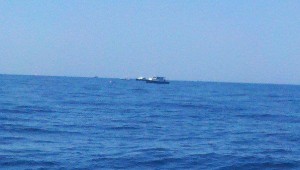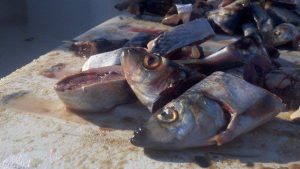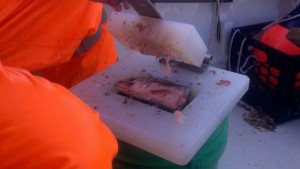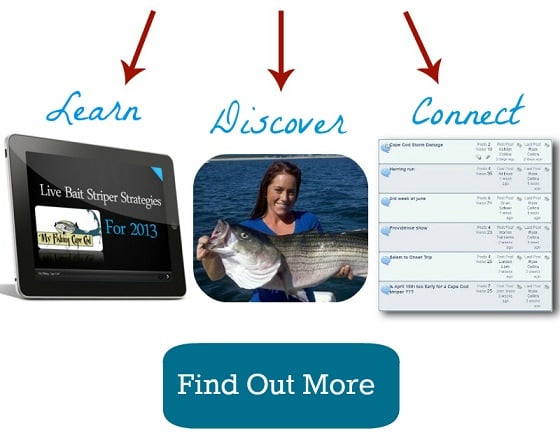Click here for the latest Cape Cod tuna fishing report
Like I've said before, we are still new to the tuna game so take everything I say here with a grain of salt. With that in mind, if you are just starting out and trying to catch your first giant tuna, then hopefully these posts help you out!

One of the most popular and effective means for catching giant bluefin tuna in Cape Cod Bay is to anchor up and chum. So far this fall, multiple 1,000 plus pound giant tuna have been caught by anglers utilizing this technique.
I was out on the tuna grounds yesterday with my good friend and fishing buddy Jason Mazzola, and although we did not hook up, we did mark 7 giants on our sonar-which goes to show that chumming does at least draw some fish into the area of your baits. Whether or not the fish bite is a completely different story!
Anchoring
Chumming works best when at anchor. It's difficult to create an effective chum slick from a drifting boat. The rule of thumb for anchoring is to use 5-7 times more anchor line than the depth at which you intend to anchor. Fortunately this is just the "recommended" amount. We have anchored up just fine using 2 times more anchor line than depth. In other words, we have been using 400 feet of anchor line when fishing in 190 feet of water.
The next step is to purchase or find an orange "ball" or float. Once anchored we run the anchor line to the ball, tie it off, and then run 200 more feet of line to the bow of the boat. This gives us ample space between our baits and the anchor line, while also allowing us to leave anchor if we hook up with a fish. After fighting the fish we can return to the ball and resume fishing.

Retrieving 400 feet of anchor line by hand is a grueling task. That's why most tuna fishermen run the anchor line through a brass ring which is connected to the ball. With the boat in gear, the captain maneuvers the vessel upwind/up-tide of the anchor until the anchor is dislodged from the bottom. The vessel continues forward, pulling the entire anchor line through the brass ring. Done correctly the anchor will become lodged in the ring and kept at the surface by the ball.
Chumming
One of the most popular fishes used for chumming is the herring. We have been chumming 50 plus pounds of herring on each of our trips this fall. I have heard of some captains chumming 100 plus pounds. When available we have thrown mackerel, menhaden and bluefish into the chumming mix.

We have purchased 55 pound blocks of herring from Norpel (in New Bedford) for $20 a block.
Cutting the chum into chunks is quite the process. If you get stuck with this smelly job, then best of luck to you!
To make chumming life easier, Mazzola found an awesome "chunking device" which has proven to be a real labor and time saver. A herring is placed on top of the device and then pushed through a set of blades-automatically cutting the herring into chunks-no knife required. It now takes us about 10 minutes to fill a 5 gallon bucket with chunks.

As mentioned above, we were able to draw quite a few big tuna to the boat yesterday, despite being on the outside of the fleet. We may have just gotten lucky, however I'll think positive and credit the success to our chumming technique.
I spent the entire day throwing small handfuls of herring chunks into the water. As soon as the last handful drifted from sight, another handful went in the drink. Needless to say the birds loved me-we had a flock at our stern the entire day.
I'm sure there are many different chumming techniques. If you have a tip or a better method, I would love to hear it-just leave a comment below.
Follow My Fishing Cape Cod on Facebook by clicking here.
Tight lines and good luck!
Ryan



Excellent read, always wanted to battle a giant Bluefin Tuna one day!
Perhaps 2016 will be your year Matt!
Ryan: I’ve never done any Tuna fishing before, but hoping this will be the year. After reading your comments above and watching every episode of “Wicked Tuna” I’m psyched to give it a go. My question is about rigging the anchor ball. After dropping your anchor, which I assume is attached to the ball, do you then run a separate line form the ball to the bow so that you can then untie the bow while using the boat to fight the fish and retrieve the anchor afterwards? Do you have to let out all of your anchor line and have a separate tether to the bow? I’ve seen a lot of You Tube videos about retrieving the anchor using a ring attached to the anchor ball but the end of the line seems to be still attached to the bow when anchored and there certainly would be no time to retrieve the anchor before fighting the fish. They don’t ever show the setup on Wicked Tuna and I can’t seem to locate any instruction on the subject. Hoping you can clear this up.
Hey Joe, perhaps 2015 will be the year of your first giant! Wouldn’t that be exciting. I’d love to see that happen.
I asked my tuna fishing buddy Jason Mazzola to shed some light on this, since he is the one who personally set up the anchor and ball we have been using for the past few seasons.
I decided to post his response in the forum, which you can view here https://myfishingcapecod.com/forum-3/cape-cod-fishing-1/giant-tuna-fishing-anchorball-setup/
Ryan,
Do you think the medium/school tuna leave the area in the Fall? I enjoy trolling and have never heard of a gaint be caught that way. What do you think<
Dave
Hey Dave,
Thanks for the comment and checking out the blog.
I believe the medium and school tuna stick around much later than most folks think. A few years ago we headed out in early December, found a large school of “small” tuna and hooked up with what was probably a 150 or so pound fish.
We ended up losing the fish but it was pretty cool to have a December hook up. November can be a good month as well, just have to be very careful with the weather.
I know guys do catch giants trolling, maybe not as often as they do with live bait but it certainly happens. I actually heard a rumor about someone catching an 800 pounder trolling east of Chatham this past week.
Hope that helps!